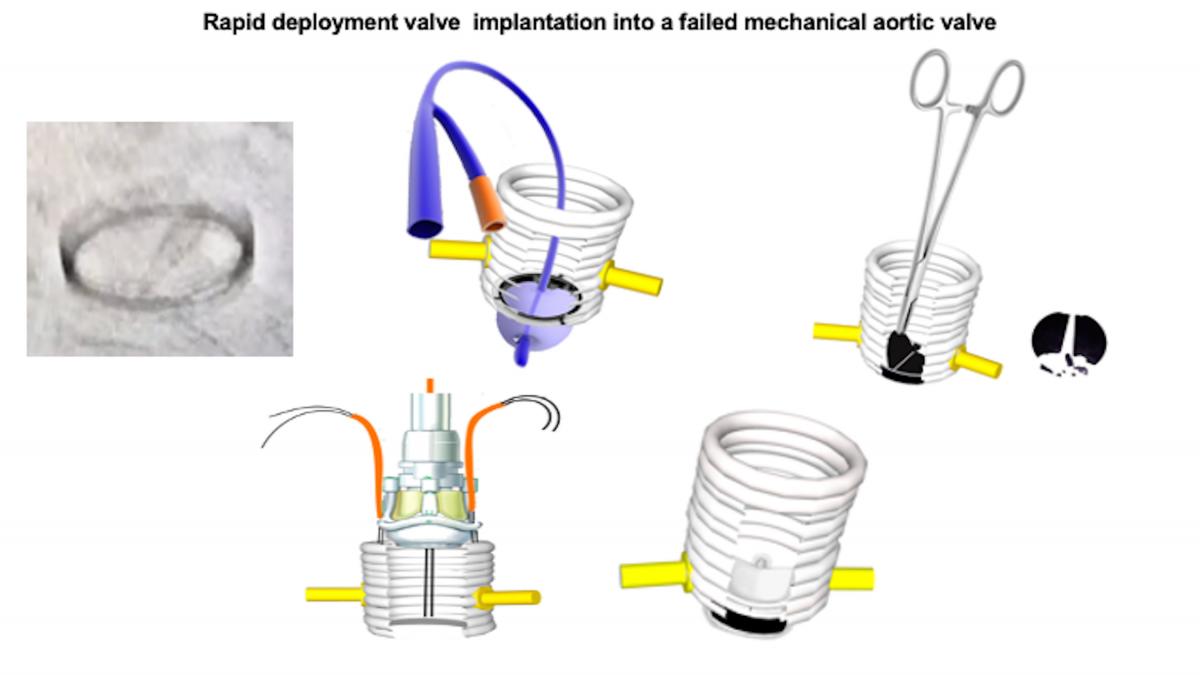ALERT!
This site is not optimized for Internet Explorer 8 (or older).
Please upgrade to a newer version of Internet Explorer or use an alternate browser such as Chrome or Firefox.
Rapid Deployment Valve Over Aortic Mechanical Valve
Cavozza C, Gherli R, Maj G, Audo A. Rapid Deployment Valve Over Aortic Mechanical Valve. June 2023. doi:10.25373/ctsnet.23523822
Malfunctioning mechanical valve prosthesis because of hypomobility of the mobile elements usually needs to be treated with the surgical redo. Re-redo surgery to replace a mechanical composite aortic root is often a challenging undertaking. This subset of patients represents a challenge for every surgeon because of the presence of cardio-pericardial adhesions, the surgical-related difficulties, and more advanced pathology.
The Patient
A seventy-five-year-old man was referred to the authors’ institution with symptoms of heart failure. The patient was severely overweight, was on chronic dialysis, and needed overnight oxygen support.
He had undergone aortic valve sparing root replacement in 2014, and an aortic root replacement for severe aortic regurgitation with a composite graft—28 mm Dacron graft containing of 23 mm bileaflet mechanical valve in 2018. In 2021, the patient had undergone surgical pannus removal for one EMI disk failure.
After the patient was admitted, a transthoracic echocardiography showed a mean gradient of 60 mmHg, an indexed aortic valve area of 0.27 cm2/m2, and decreased biventricular ejection fraction. A CT angiography showed slightly reduced excursion of one of the mechanical leaflets. There was no evidence for an acute thrombosis. Fluoroscopy and coronary angiography confirmed the fixation of one tilting disc and showed no critical coronary stenosis.
The Surgery
The operative plan for the reoperation was to minimize the duration of CPB by using a rapid deployment Intuity bioprosthesis.
Previous work has shown that the Intuity valve with a 4 mm diameter, smaller than that of the mechanical valve, has an orifice that matches that of the mechanical prosthesis. The surgeons were able to fracture both EMI discs of a mechanical valve while explanted. A rapid deployment valve was easy implanted.
In this case, the aortic conduit was exposed after a redo sternotomy and takedown of very tenacious adhesions. The Dacron graft was opened, exposing the mechanical prosthesis and EMI disk blocked. A bladder catheter was inserted within the left ventricular outflow tract and pulled against the inferior margin of the mechanical prosthesis to prevent tiny fragments dispersion. The valve leaflets were unhinged with a needle holder from the prosthetic housing, and the few prosthetic fragments were easily retrieved. Six single sutures where then passed through the sewing ring of mechanical valve, and a 19 mm Intuity valve was lowered in mechanical anulus.
At this point, anchoring sutures may be placed by passing only one needle from each pair in a circumferential direction through the cuff of the valve anulus. Alternatively, each needle from every pair can be passed from the orifice side to the periphery of the anulus cuff. The sutures were then passed through the cuff of the bioprosthesis (Figure 1).

Figure 1
Apposition of the valve against the aortic annulus was then complete, with coronary ostia unobstructed. The Dacron graft was closed with two Dacron patches and the patient was weaned from CPB. A transesophageal echocardiography showed no paravalvular regurgitation, and maximal and mean transprosthetic gradients were 18 and 12 mmHg respectively (Video 1).
Video 1
Cardiopulmonary bypass time and cross-clamp time were fifty-nine and thirty-eight minutes, respectively.
The postoperative course featured prolonged mechanical ventilation, but the patient was discharged to rehabilitation facility.
Conclusion
Aortic root reoperations are challenging and fraught with 5 percent to 11 percent morbidity and mortality (3) rates. Conversion from mechanical to a xenograft valve conduit has already been described (2, 4, 5).
The advantage of Intuity valve implant satisfied the surgical objectives, and the excellent long-term results on clinical follow-up and echocardiographic evaluation have led this to be a method of choice in select, very challenging patients.
References
- Deng, J., Zhong, Q. Clinical analysis of redo aortic root replacement after cardiac surgery: a retrospective study. J Cardiothorac Surg 16, 202 (2021)
- Okiwelu NLE, Ramponi F, Thakur S,Vo T, Edwards J. Tissue “valve‐over‐valve” implantation in previous mechanical Bentall. J Card Surg. 2020;35:3645–3647.
- Szeto W, Bavaria JE, Bowen F, et al. Reoperative aortic root replacement in patients with previous aortic surgery. Ann Thorac Surg. 2007; 84: 1592- 1598.
- Luca A. Vricella and Duke E. Cameron. Facile conversion from mechanical to bioprosthetic composite aortic root replacement. J Thorac Cardiovasc Surg 2007;133:565-7
- Christian Butter, Ralf-Uwe Kühnel, Frank Hölschermann. First successful transcatheter valve-in-valve implantation into a failed mechanical prosthetic aortic valve facilitated by fracturing of the leaflets: a case report, European Heart Journal - Case Reports, Volume 5, Issue 7, July 2021, ytab130
Disclaimer
The information and views presented on CTSNet.org represent the views of the authors and contributors of the material and not of CTSNet. Please review our full disclaimer page here.




